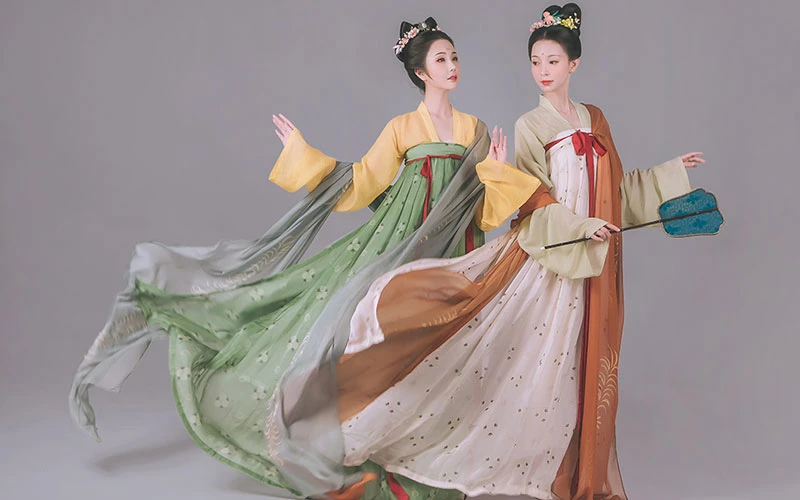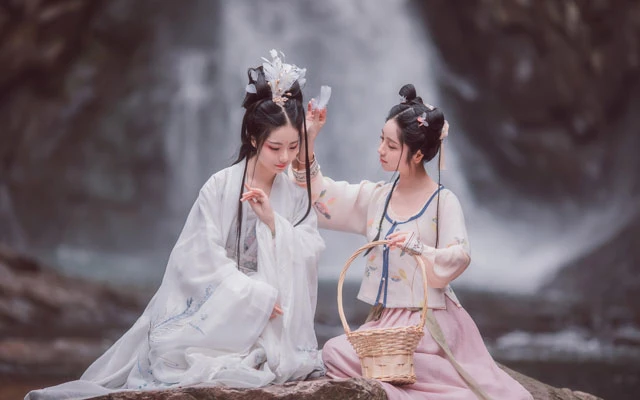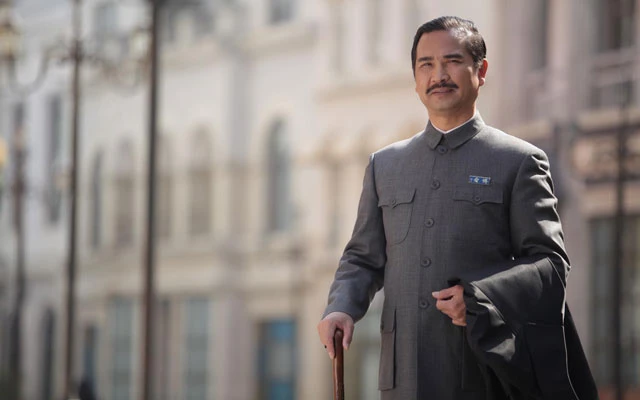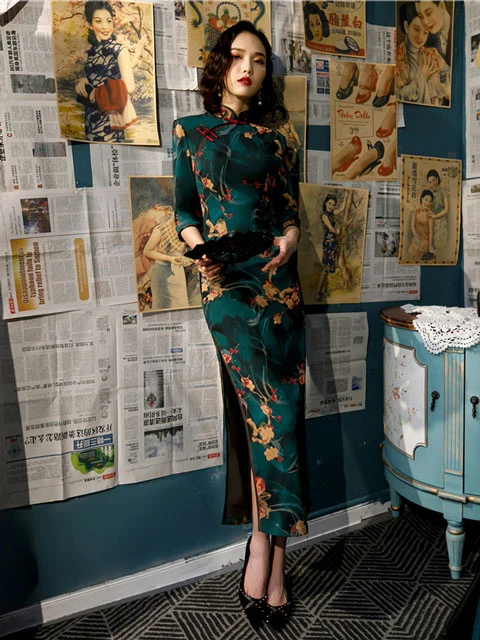As in all countries, clothing plays an important role in Chinese culture.
Chinese culture has existed for over 5000 years, and during this time some traditional clothing has been created.
Traditional Chinese clothes are often based on the religion and social status of the person wearing them.
Traditional Chinese clothes usually have a straight cut that is not too tight. This makes the clothes comfortable to wear. Light colors are most popular, but you can also find red, yellow, and purple clothes surprisingly often. White is considered the color of mourning in China and is therefore rarely worn in everyday life.
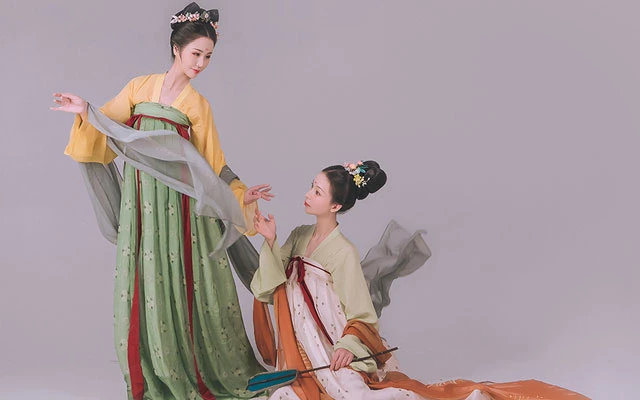
In imperial times, the colors red, yellow, and purple were reserved for the ruler, his family, and high nobles. Today, red clothes are particularly popular, because the color stands for happiness and prosperity. This is the reason why many Chinese wear red clothes, especially on Chinese New Year.
Chinese women's clothing is often more detailed and decorated with more embroidery than men's clothing. Everyday clothing is usually made of cotton or linen. On special occasions, people wear traditional clothing made of silk.
To this day, there are four traditional Chinese garments that are still worn by many Chinese people:
1. Traditional Chinese clothing - Hanfu
History:
The Chinese Hanfu (汉服) is the oldest traditional garment. As the name suggests, this garment was developed during the Han Dynasty (206 BC - 220 AD).
Today, many Chinese consider themselves to still be associated with the Han Dynasty. The largest population group in China is the Han Chinese. Therefore, the heritage from this period is considered very important.
Name:
The literal translation of Hanfu is "clothing of the Han ethnic" - 汉(Han ethnic) + 服(clothing).
Main features:
- Crossed collar
- Right collar lapel
- Sash instead of buttons
- Colorful embroidery
Design:
The hanfu comes in two versions: a one-piece robe or a combination of a skirt and pants. The robe consists of three parts - underwear, an inner robe, and a coat. In addition, socks, a shawl, and a belt are traditionally worn with it, as well as jewelry made of jade.
The embroidery on the dress depends on the social status of the person wearing the hanfu. Sun, moon, and animals like tigers, dragons or birds are popular motifs for Chinese embroideries. In addition, expensive materials of good quality are almost exclusively used to make the hanfu. These include silk, brocade, and wool.
2. Traditional Chinese clothing - Zhongshan suit
History:
The Zhongshan suit (中山装), also known as the Mao suit, dates back to the early days of the Republic of China around 1912.
Since this traditional Chinese garment was later often worn by the founder of the People's Republic, Mao Zedong, the name "Mao suit" also gradually became common.
The idea behind this garment was to combine Western and traditional Chinese clothing styles.
Name:
The Chinese name is 中山服 (Zhōngshān fú). Zhōngshān is the Chinese name of Sun Yat-sen, the founder of the Chinese Republic. "Fú" means clothes or suit.
Main features:
- Turned down, closed collar
- Four pockets
- Five buttons in the middle
- Three smaller buttons on each sleeve
Design:
Although the suit looks quite plain, its features all have symbolic meaning. The four pockets represent loyalty, goodness, decency, and shame. The five large buttons on the front of the top represent the five areas of the Chinese constitution: administration, jurisdiction, legislation, supervision, and control. The three small buttons on the sleeves of the Mao suit represent the three principles of the people. These are nationalism, democracy, and the existence of the state. The turned-down collar is a sign of a conscientious style of rule.
3. Traditional Chinese clothing - Tangzhuang or Tang suit
History:
And again, the Chinese name of a traditional Chinese garment was derived from a dynasty - the Chinese Tang Dynasty. Although this garment is called a suit, it only consists of a top.
Name:
The name "Tang suit (唐装)" was given to this top by traders from Western countries. The Tang Dynasty was the most famous Chinese dynasty in the West at that time. Therefore, this traditional Chinese garment has been given the name of the Chinese imperial dynasty.
This is because the Chinese were called the "Tang people" at that time. Therefore, Tangzhuang (唐装) means "suit of the Chinese".
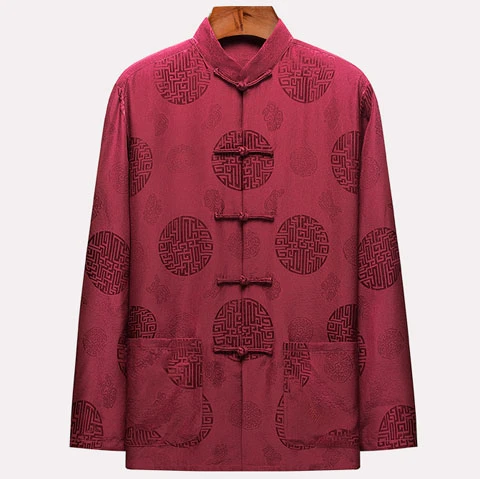
modern tang suit
Main Features:
- Loose fit
- Mandarin collar
- Fabric buttons on the front
Design:
On a traditional Tang suit, you will usually also find some Chinese characters, for example, those for good luck (福) and longevity (寿). These characters are said to bring prosperity and satisfaction to the wearer of the suit.
This traditional Chinese garment had a great influence on traditional clothing in Japan, Korea, and Vietnam.
4. Traditional Chinese clothing - Cheongsam or Qipao
Background:
Cheongsam, also called Qipao (旗袍), is a Chinese dress that originated during the Qing Dynasty (17th - 20th centuries). It is based on the dress style of Manchu women.
Name:
At the time when the Cheongsam was first worn, the Han Chinese still called the members of the Manchu people the "Qi people". Manchu women wore long dresses at that time, and the Chinese word for the dress is "pao". Qi pao, when put together, means "dress of the Qi people". The qipao is worn exclusively by women.
Main Features:
- Figure-hugging cut
- One-piece dress
- The right side is knotted with fabric buttons
- Two wide openings on both sides of the hips
Design:
The Qipao is a one-piece figure-hugging dress worn by many Chinese women today, as well as tourists. The dress combines traditional Chinese elements with a modern cut.
For more on the topic of traditional Chinese costumes and various types of Hanfu, please click here.
